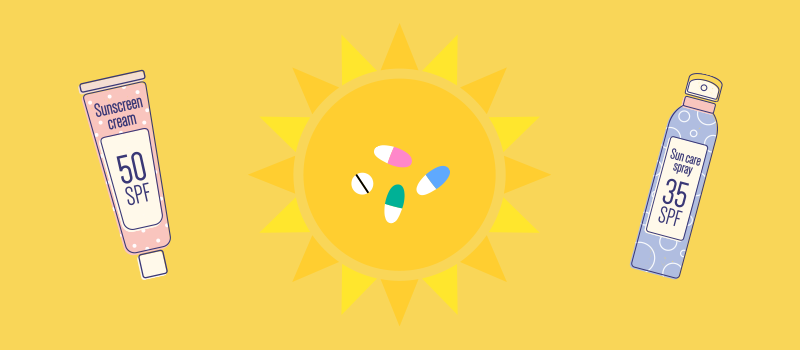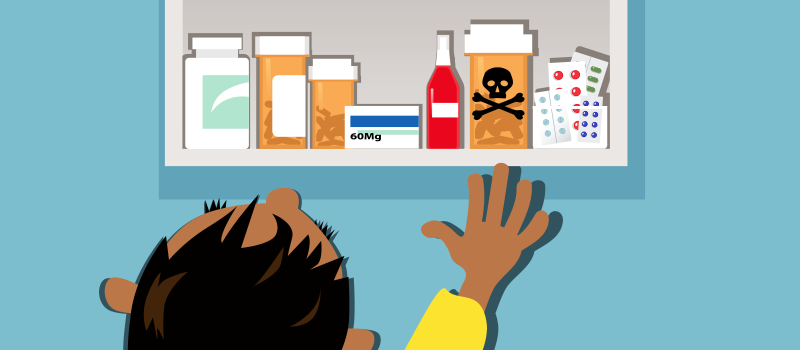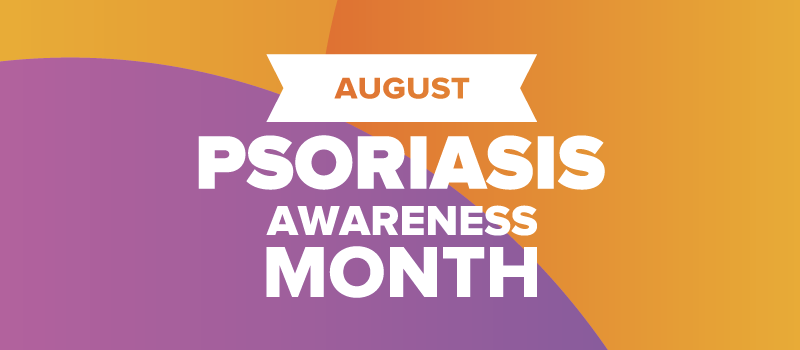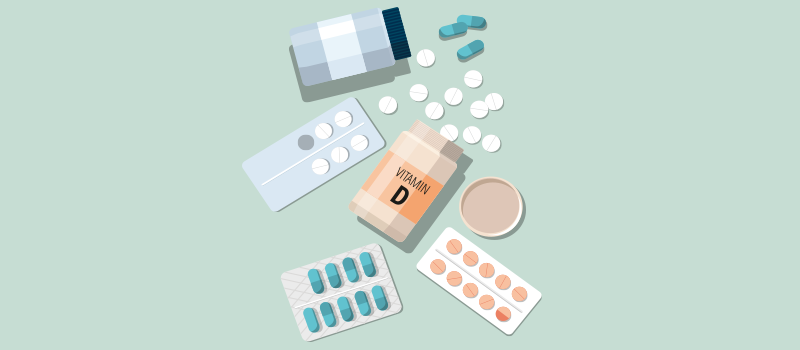What’s the Buzz
The Bee Healthy Blog
What Medications Can Cause Sun Sensitivity?

Skin is the largest organ of the body. Skin, hair, nails, sweat, and oil glands make up what is known as the integumentary system. According to the Skin Cancer Foundation, one in five Americans will develop skin cancer by age seventy.5 To help prevent skin cancer, sunscreen with adequate SPF (sun protection factor) is highly recommended, especially in the summer. However, there are other factors that could potentially make you more sensitive to sunlight. It’s important to know that specific medications can also cause or increase the risk of photosensitivity. Continue reading to learn more.
What is photosensitivity?
Photosensitivity is the medical term for sun sensitivity. Drug-induced photosensitivity refers to how chemicals or drugs are ingested orally or applied topically to promote a photosensitive reaction when the individual is exposed to sunlight.1 The “Photosensitivity reactions in the elderly population” study reveals that photosensitivity is responsible for up to 20 percent of adverse drug reactions in older adults.3 Photosensitivity is categorized into two subtypes: phototoxicity and photoallergy. So what is the difference between these two reactions?
Phototoxicity vs. Photoallergy
A phototoxic reaction appears as a severe sunburn. This reaction occurs within a short time frame, typically within minutes to hours after sun exposure, and it only happens to the areas of skin exposed to the sun. The mechanism is similar to sunburn in which skin tissue or cells are damaged by ultraviolet (UV) rays. The only difference between a sunburn and phototoxicity is that the latter is induced by oral drugs or topical agents, while sunburn is just skin tissue being damaged from prolonged exposure to UV rays.1,2
On the other hand, a photoallergy is a delayed, hypersensitive reaction to an allergen. Similar to phototoxicity, the allergen can be topical, oral chemicals, or drugs. While phototoxicity happens within minutes to hours, photoallergy develops 24 to 48 after sun exposure.6 Symptoms of photoallergy appear to be the same as allergic contact dermatitis, also known as contact eczema. The affected skin may be red and itchy, swollen and blistered, or dry and bumpy.4 It is interesting to know that occasionally, photoallergic contact dermatitis remains persistent even after discontinuation of the offending agent and may become a chronic condition. While systemic and topical agents can cause phototoxicity and photoallergy, topical agents are more responsible for photoallergic reaction than systemic agents such as oral and injectable drugs.6 The table below highlights the similarities and differences between phototoxicity and photoallergy.
| Phototoxicity | Photoallergy | |
| Incidence | High | Low |
| Amount of agent required for photosensitivity | Large | Small |
| Onset after exposure to photosensitizer and light | Minutes to hours | 24 hours or more |
| Symptoms | Exaggerated sunburns | Acute, subacute, and chronic dermatitis |
| Distribution | Exposed skin only | Exposed skin, may spread to unexposed skin |
| Changes in pigmentation | Frequent | Unusual |
Drug-induced phototoxicity
Phototoxicity is the most common cause of drug-induced photosensitivity. Below is the list of drugs and drug classes that are known for having phototoxic adverse effects, their indications, and the commonly known brand names.
Common Medications That Cause Photosensitivity | |
| Drug classes and common medications within the class | Indication |
| NSAIDs (nonsteroidal anti-inflammatory drugs): piroxicam and ketoprofen have a very high incidence of photosensitivity than other agents in this drug class | Treatment of mild to moderate pain, inflammation, and fever. |
| Sulfonamides- this is not a drug class, but rather the basis of many drugs that contain sulfa. Examples are trimethoprim/sulfamethoxazole (Bactrim), sulfasalazine (Sulfazine), zonisamide (Zonegran) | Trimethoprim/sulfamethoxazole (Bactrim): antimicrobial agent Sulfasalazine (Sulfazine): treatment of rheumatoid arthritis Zonisamide (Zonegran): treatment of seizures |
| Hydrochlorothiazide (Microzide) | Diuresis and treatment of hypertension |
| Metformin: Glucophage, Glucophage XR, Fortamet, Glumetza | Treatment of pre-diabetes and type 2 diabetes |
| Fluoroquinolones: ciprofloxacin (Cipro), levofloxacin (Levaquin), moxifloxacin (Avelox), ofloxacin | Antimicrobial agent |
| Phenothiazines: prochlorperazine (Compazine), fluphenazine (Prolixin), perphenazine | Treatment of schizophrenia, psychotic disorders, nausea, and vomiting |
| Voriconazole | Antifungal agent |
| Griseofulvin | Antifungal agent (treatment of ringworm) |
| Amiodarone | Treatment of arrhythmia (irregular heartbeat) |
| Retinoids -topical – Retinol, tretinoin, adapalene, tazarotene, alitretinoin, bexarotene | Treatment of inflammatory skin disorders, acne, and wrinkles |
| St. John’s wort – over the counter herbal supplement | Treatment of depression |
| Sulfonamides- this is not a drug class, but rather the basis of many drugs that contain sulfa. Examples are trimethoprim/sulfamethoxazole (Bactrim), sulfasalazine (Sulfazine), zonisamide (Zonegran) | Trimethoprim/sulfamethoxazole (Bactrim): antimicrobial agent Sulfasalazine (Sulfazine): treatment of rheumatoid arthritis Zonisamide (Zonegran): treatment of seizures |
Drug-induced photoallergy
As mentioned, topical agents are more likely to cause photoallergic reactions. However, some of the oral medications that can cause photosensitivity can potentially lead to photoallergy.
Topical agents that may cause photoallergic reactions include:
- Antimicrobial agents: chlorhexidine, hexachlorophene, fenticlor
- Topical NSAIDs: ketoprofen, diclofenac
- Sunscreens containing benzophenones, cinnamates, and dibenzoylmethanes
- Fragrances containing 6-methylcoumarin, musk ambrette, sandalwood oil
Systemic agents that may cause photoallergic reactions:
- Quinidine: Treatment of arrhythmia
- Griseofulvin: Antifungal agent (treatment of ringworm)
- Fluoroquinolones: ciprofloxacin (Cipro), levofloxacin (Levaquin), moxifloxacin (Avelox), ofloxacin
- Sulfonamides: As mentioned above, these are sulfa-containing drugs such as trimethoprim/sulfamethoxazole (Bactrim), sulfasalazine (Sulfazine), zonisamide (Zonegran)
- NSAIDs: ketoprofen, piroxicam
Diagnosis:
To differentiate between phototoxicity and photoallergy, a complete skin examination by a dermatologist is required. If the skin examination is insufficient to provide an accurate diagnosis, phototesting or photopatch may be helpful.6
Treatment of phototoxicity and photoallergy
The first step in treating both phototoxicity and photoallergy is to discontinue using the aggravating chemicals or drugs as soon as possible. It’s also important to take sun-protective measures, which include:
- Avoid midday sun (between 10:00 AM and 4:00 PM)
- Wear protective clothing pieces: long sleeve shirts and pants, broad brim hats
- Use window films that block ultraviolet radiations for cars and homes
- Use broad-spectrum sunscreen to protect against ultraviolet A (UVA) and ultraviolet B (UVB) rays.
Most phototoxic reactions can be treated as sunburn, which can be self-limited, where the acute manifestation can be resolved on its own within three to seven days.
Pain and discomfort can be alleviated with the following methods:
- Cold compression or soaks
- Calamine lotion or aloe vera based gels
- Ruptured blisters should be cleaned with mild soap and water and covered with a wet dressing
- The use of ibuprofen (Advil) 400 mg to 800 mg per dose taken three to four times per day for adults and children of at least 12 years of age, with no history of kidney disease, is appropriate to treat skin pain and inflammation
- Local anesthetics (numbing agents) are not recommended due to the possibility of contact allergy.
It’s always a good idea to talk to your doctor or pharmacist about the possible side effects of your medication, including if they may cause drug-induced photosensitivity. Even if you’re not on a sensitizing medication, it’s always important to wear sunscreen daily.
References:
1. González E, González S. Drug photosensitivity, idiopathic photodermatoses, and sunscreens. J Am Acad Dermatol 1996; 35:871.
2. Khandpur S, Porter RM, Boulton SJ, Anstey A. Drug-induced photosensitivity: new insights into pathomechanisms and clinical variation through basic and applied science. Br J Dermatol 2017; 176:902.
4. https://dermnetnz.org/topics/allergic-contact-dermatitis/
5. https://www.skincancer.org/skin-cancer-information/skin-cancer-facts/
6. Monteiro AF, Rato M, Martins C. Drug-induced photosensitivity: Photoallergic and phototoxic reactions. Clin Dermatol 2016; 34:571.












SOCIAL